225 vs 245 Tires: 9 Parameters to Look into Before Buying
Choosing between 225 vs 245 tires can be a challenging task for drivers. If you are looking for helpful guides to select the right tire, look no further. Discover their features, advantages, disadvantages, and factors that will point you in the right direction during your selection.
Let’s get into it straight away.
Table of Contents
225 vs 245 Tires: A Quick Look at Differences
These tires possess several differences based on their structure. The main difference between the two is their tire size. Below are some of their other contrasting characteristics:
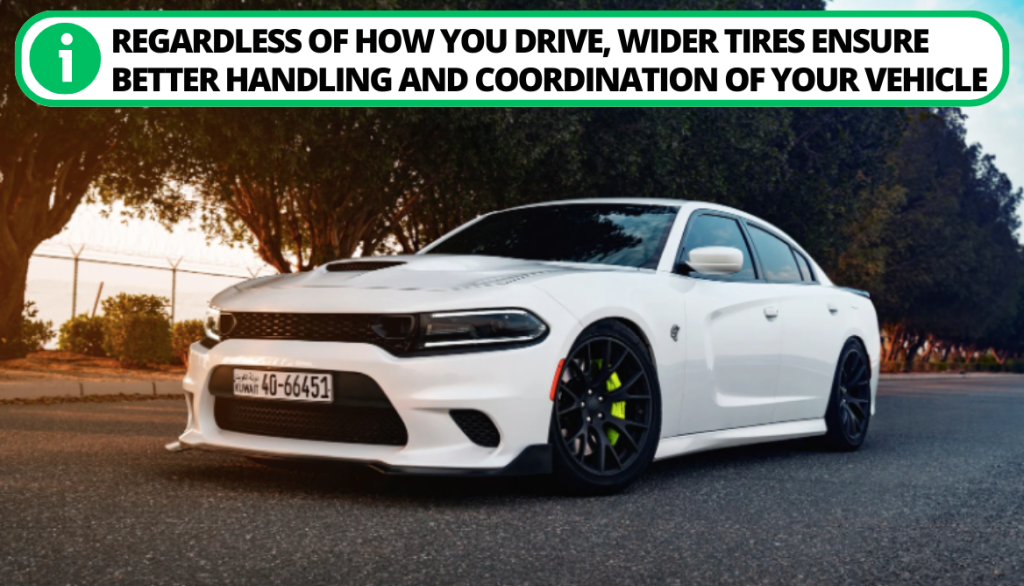
- Tire Height: Refers to the distance from the ground to the top of a tire when properly inflated and mounted on the wheel.
- Tire Width: This tire measurement is taken from one sidewall to another when properly inflated. A 245 tire is a wider tire that provides a larger contact patch. 225 tires, however, are narrower tires.
- Sidewall Height: Sidewall height is measured from the wheel’s rim to the outer tread surface. It is narrower with the 225 tires and thus has a reduced sidewall height vs. 245 tires.
- Rolling Resistance: The friction experienced during road navigation minimizes tiers’ rolling and improves fuel efficiency. Wider 245 tires get more rolling resistance due to increased contact with the road surface, needing more fuel to maneuver. The smaller 225 tires experience less rolling resistance, providing a higher gas mileage, thus making it more effective.
- Carload: Bigger tires can handle heavier loads. Therefore, the 245 tire has a higher load and is designed to handle medium carloads. 225 tires, on the other hand, aren’t that large, only handling restricted to lighter loads.
- Comfort: 225 tires are built for comfort. They better absorb road imperfections and emanate less noise and vibrations. The 245 tire is more prominent and ensures you feel every vibration, significantly reducing your ride comfortability.
- Braking Distance: Bigger tires provide better braking qualities as they have deeper treads, hence more grip on the road. Additionally, the wider contact patch area ensures that the tires can adequately access the road compared to 225 tires.
- Grip: A wider tire is bound to contain a structured tread pattern. This feature equips you with a proper grip on the road. Therefore, 225 tires will automatically have a smaller tread covering.
- Handling: Regardless of how you drive, wider tires ensure better handling and coordination of your vehicle.
- Cost: 225 tires are more economical than the two tires, mainly due to their size. They use less rubber and therefore cost less. However, it is important not to compromise on quality based on cost.
Quality | 225 Tires | 245 Tires |
Tire Height: | High | Higher |
Tire Width: | Wide | Wider |
Sidewall Height: | High | Higher |
Rolling Resistance: | Lower | Higher |
Carload: | Lighter Load | Medium Load |
Comfort: | Most | Less |
Braking Distance: | Short | Shorter |
Grip: | Least | Less |
Handling: | Good | Better |
Cost: | Cheapest | More Expensive |
Advantages of 245 and 225 Tires
The numbers 245 and 225 represent the tire’s measurement in millimetres. Let’s look at some of the benefits of these tires.
Benefits of 245 Tires
Here are some of the pros you will get from these tires:
- Enhanced grip: This results from the broader contact area with the road. Furthermore, they have deep, significant tread patterns that also aid this.
- Increased Load Carrying Capacity: A 245 tire offers more support and endurance when carrying medium loads. The width difference greatly aids in load control.
- Improved Handling: They have a more comprehensive overall diameter that aids in providing a better grip on the road. This feature ensures that they offer better steering capabilities.
- Increased Stability: Their wider footprint offers more stability and tends to have a lower aspect ratio.
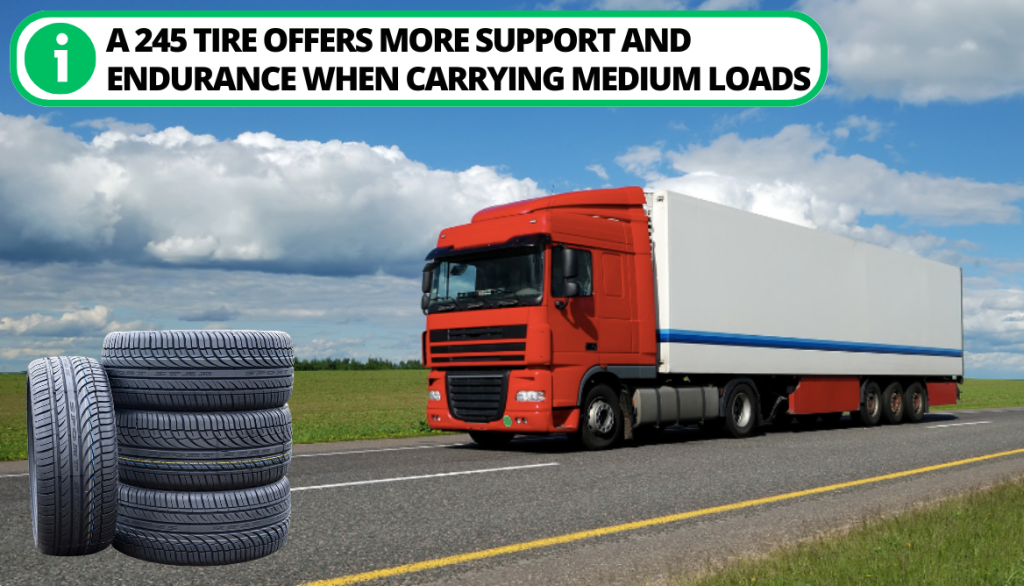
Disadvantages of 245 tires
Here are some of the cons that these tires possess:
- Reduced Fuel Efficiency: These wheels experience a higher rolling resistance which consumes more fuel.
- Reduced Ride Comfort: The tires are infamous for producing more noise and vibrations during rides reducing your experience.
Benefits of 225 Tires
Let’s look at some of the benefits of 225 tires:
- Improved Fuel Efficiency: Unlike their larger counterpart, these tires are more fuel economical as they don’t require much energy to move.
- Increased Ride Comfortability: They are designed to absorb road imperfections. Furthermore, they emanate less noise and vibrations.
- More Economical: 225 tires cost less to manufacture and thus are affordable. They are a suitable option if you are on a budget.
- Improved Winter Traction: These tires have a reduced width that enables them to cut through icy and snowy terrains providing better traction in these conditions.
- Improved Maneuverability: They can easily maneuver in small spaces based on their narrow rim width.

Disadvantages of 225 tires
Let’s look at some of the cons of these tires:
- Longer Braking Distance: These tires are narrower and hence take longer to slow down after breaking due to road contact.
- Reduced Traction on Certain Surfaces: These tires have a smaller contact area with the road, which may lower their grip on slippery surfaces.
Unique Characteristics of 225 vs 245 Tires
As explained above, these tires have varying features based on size, weight, carrying capacity, width difference, etc. Let’s examine some of their qualities and how they affect your driving.
Qualities of 225 Tires
225 tires are a small tire size containing other different qualities that impact their overall performance. Let’s review some of them.
1. Agility and Degree of Responsiveness
A 225 is smaller, making its response time faster. The narrow width facilitates faster turn around and transitions, thus suitable for cruising through close city spaces.

2. Fuel Economy
These tires are made for you if you want a car with a higher gas mileage per square inch. With reduced rolling resistance, 225s require less moving force. This feature ensures they use less fuel, minimizing cost via better fuel economy.
3. Weight Amount
The 225 tire is lighter and narrower, with a shorter rim diameter, effectively enhancing your car’s weight distribution.

Qualities of 245 Tires
A 245 is generally larger, contributing to most of the following characteristics:
1. Enhanced Grip and Traction
Cars with a more significant surface from their tire size have a larger contact patch, and experience fortified stability. Additionally, these tires have deep, complex treading that provides a better grip bettering your driving experience.
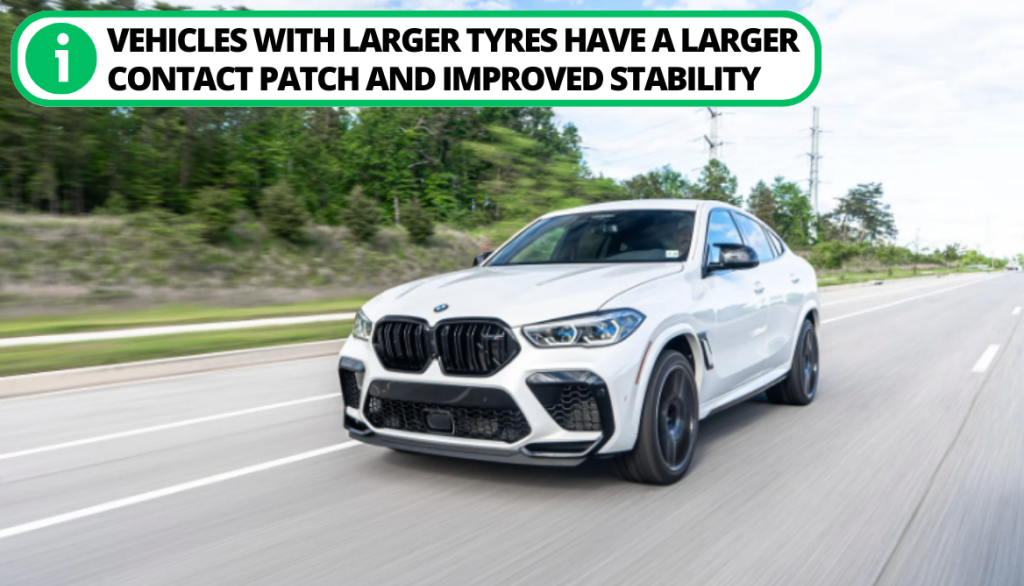
2. Stability and Handling
They offer fortified stability based on their tire size. They possess a broader print that offers a fortified frame to support your car. This makes the wider tire more beneficial when maneuvering rugged terrain
3. Improved Braking Performance
A vehicle fitted with a 245 tire takes a shorter braking distance to stop when the brakes are hit. Their large tire size provides this feature by increasing the action with the ground.
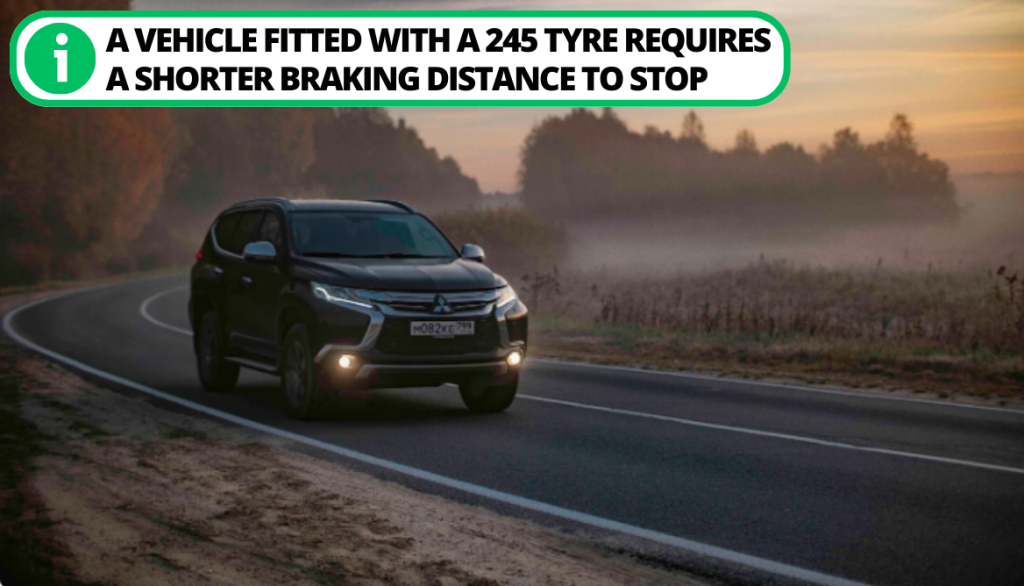
Comparing the 9 Different Parameters for 225 vs 245 Tires
The 225 and 245 tires have different contrasting qualities that constitute their make-up. Let’s look at some characteristics that make these tires unique.
1. Tire Height
When contrasting tire height, it is imperative to account for the aspect ratio and the wheel diameter. Some tires could have the same aspect ratio but have one taller than the other. However, the 245 tire is taller than the 225 tires.
Winner: 245 varieties are taller due to their large tire size, which ensures your tire has an improved grip, which assists in cornering.
2. Tire Width
Tire sizes largely influence the width of a tire. A 245 tire displays a higher width difference compared to a 225 type. The two tire sizes serve different functions hence the varying widths.
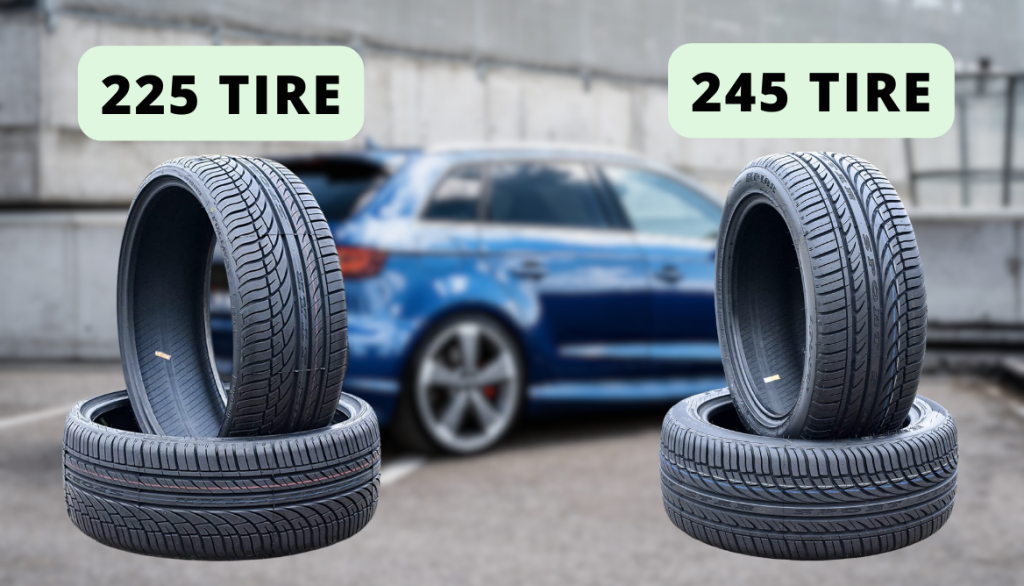
Winner: The 245 tire is larger and has a larger width ensuring the contact area with the road is increased, thereby improving stability.
3. Sidewall Height
Generally, tires with high aspect ratios and low-profile tires possess a taller sidewall height. The 245 tire is considered a low-profile tire and thus has a boosted sidewall height compared to the 225 tire.
Winner: Regardingsidewall height, 245 tires are higher, providing your car with adequate clearance.
4. Rolling Resistance
The 245 tire experiences increased rolling resistance due to its size requiring extra power to move. When fitted on your vehicle, they minimize the gas mileage due to increased utilization. The 225 tire being uniquely smaller, undergoes less rolling resistance, increasing fuel efficiency.
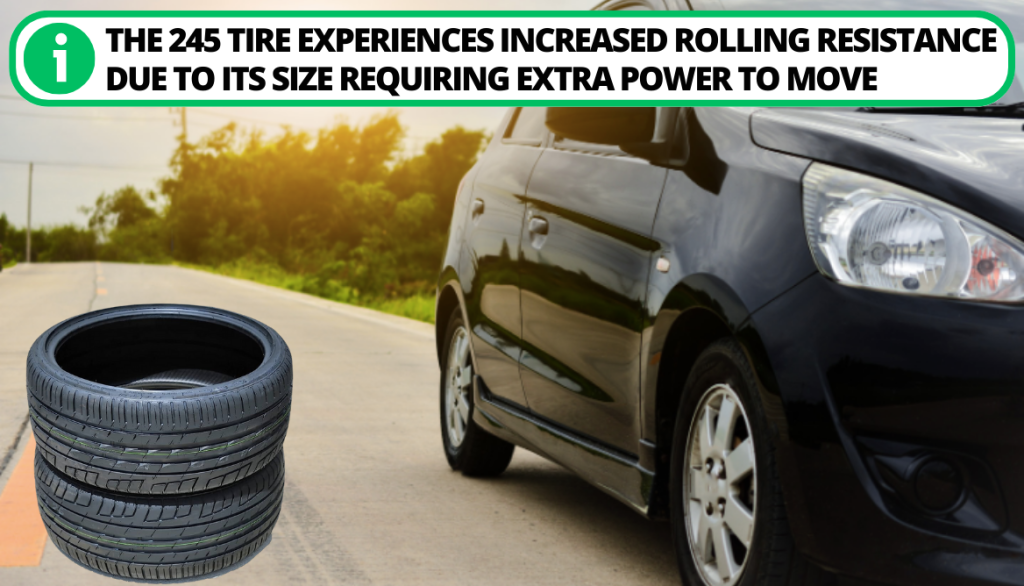
Winner: 225 tires take this round because they face reduced rolling resistance, thus saving on your fuel.
5. Carload
Big tires have a wider diameter and thus can take a decent amount of weight, enabling them to handle medium carloads. Designed to carry medium loads, the 225 tires are narrower tires and are unable to facilitate heavy weights.
Winner: The 245 tire secures this round because it can handle a heavier load than a 225 tire.
6. Comfort
The 225 tire is customized to handle road imperfections. It absorbs vibrations and makes less noise. Wider tire sizes produce more noise and vibrations despite your driving style.
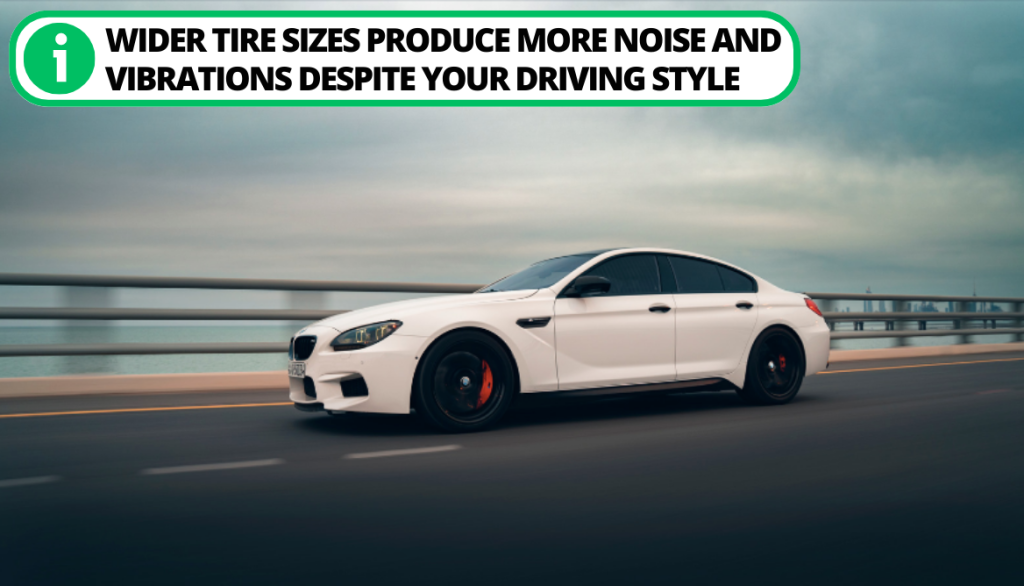
Winner: 225 tires ensure your vehicle delivers a smooth riding experience vs 245 tires.
7. Braking Distance
The two tire sizes have great braking power though the more significant 245 types provide a shorter distance once you hit the brakes. This makes them more efficient, unlike a 225 tire, especially during emergencies.
Winner: The 245 tire tops this sector by providing adequate braking distance, unlike the 225 tire.
8. Grip and Handling
Wheels with proper traction translate into improved grip. Wider tires have great diameters ensuring your vehicle has sufficient contact with the road. This feature improves your steering preventing accidents.

Winner: 245 tires have better griping and steering than 225 tires.
9. Cost
If you are on a budget, purchasing 225 tires is a good option. Manufacturers use less material to make them, thereby being cheaper than their broader counterparts.
Winner: 225 tires are more economical due to the size difference.
Are 225 And 245 Tires Interchangeable?
Yes, swapping tires is possible. Let’s look at some parameters that favor this.
Specification | 225 Tires | 245 Tires |
Diameter: | 721.4mm | 749.4mm |
Circumference: | 2266.34mm | 2354.31mm |
Sidewall Height: | 157.5mm | 171.5mm |
Changing your tires is possible, provided your vehicle has enough room and rim width to accommodate either wheel. Furthermore, review other factors like the rim size.
Our Verdict: Which Tire Is Winner
After going through the options, we recommend going with the 245 tires. These tires have numerous benefits, including:
- Improved traction.
- Better grip.
- Increased load-handling capacity.
FAQ
Is There a Big Difference Between 225 and 245 Tires?
There’s a big difference between 225 and 245 tire sizes. The former is bigger than the 225 tires, offering several pros.
Can I Replace 225 Tires With 245?
225 tires can be replaced with 245 tires, allowing enough room for ground clearance. Furthermore, look into factors like rim width and load amount.
Are 245 Tires Wide?
245 tires have a wider width to facilitate enough traction for their movement in extreme weather conditions and wet roads. Additionally, it ensures stability during driving.
Is 225 a Good Tire Size?
225 tires are a good size depending on your type of car. If you have a standard vehicle, then yes, it’s a good tire.
Is It OK to Put Wider Tires on My Car?
It is ok to put wider tires in your car. However, it would be best to consider certain factors, such as the amount you wish to carry.
Conclusion
That’s all we had on selecting between the 225 vs 245 tires. Though it can be challenging to choose between one of the two tires, you can consider different variables, like your driving preferences or the specific use of the tires.
Our final verdict favors the 245 tires, an exquisitely better option than the 225 tires. It offers an improved grip, better handling, and better load-carrying capacity.
So which tire will you choose? Let us know in the comments.

I`m a current Law Enforcement Officer working within the Counterterrorism Bureau in New York State. I have been Camping for over 20 years. My styles of camping include tent, car, truck, van, and RV travel trailer. I have a YouTube channel where I teach all types of camping with an entertaining method: https://youtube.com/@TheSmallsRVAdventures

![Best Campervan Interior Design Ideas [+Gallery]](https://camperlife.co/wp-content/uploads/2019/04/Campervan-interiors-ideas-7.jpg)




